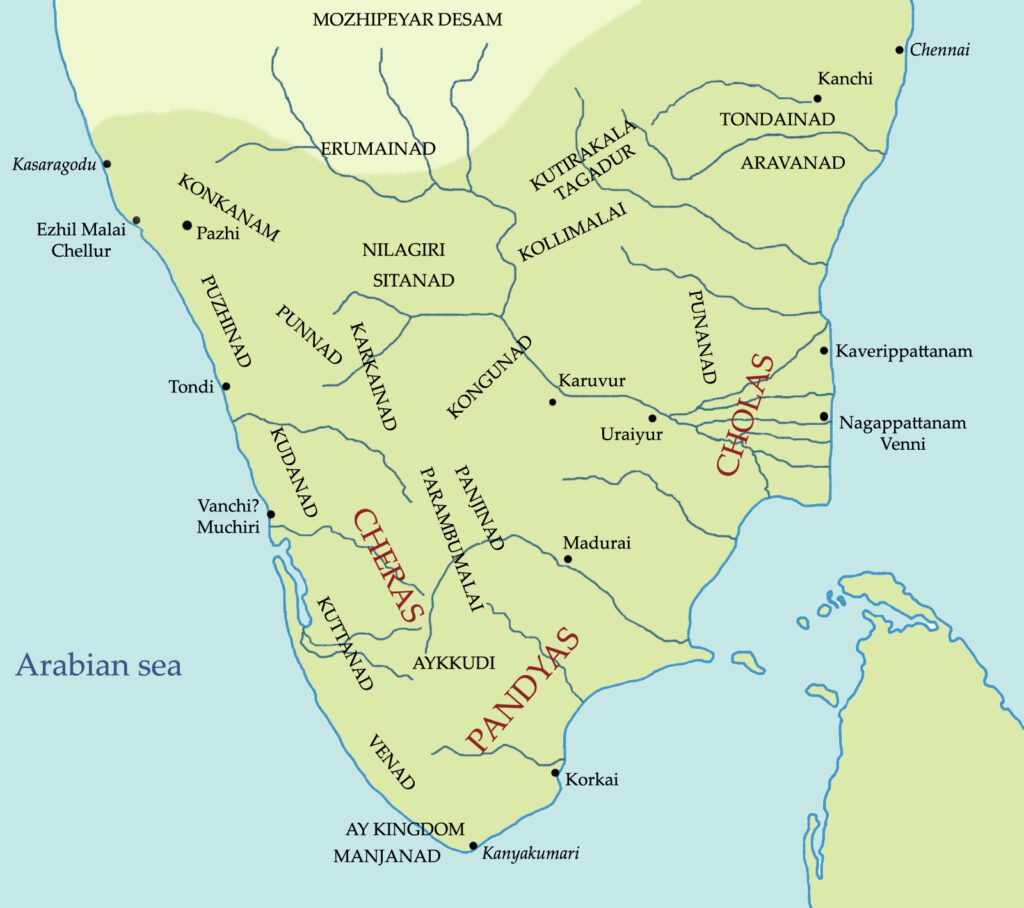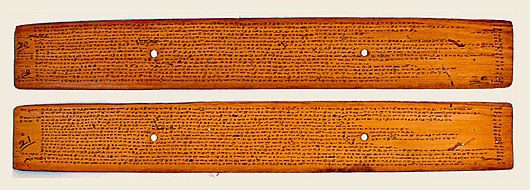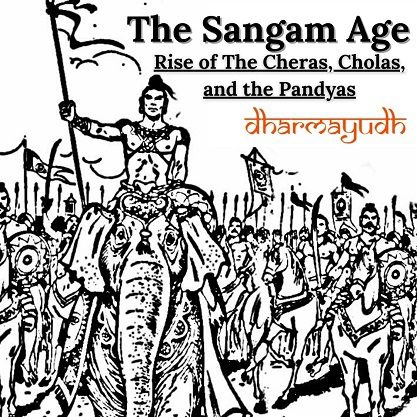The Indian subcontinent is gifted with several cultures. These different cultures are the identity of our country. These cultures and their centuries-old history had fascinated renowned historians of the world.
In this article, we will shed light on the culture which flourished in the region of Southern India. The region below Deccan became prosperous during a period known as The Sangam Age.
Most of the vital information about South Indian history is recorded in the texts which were written during Sangam Age. It was during this age when the region of the far south (the region beyond Deccan) made immense progress in the field of literature, economy, and culture.

The second and twelfth rock edict of Ashoka mentioned the names of four prosperous kingdoms of the Far South namely Cholas, Pandyas, Satyapura, and Ceylon.
Furthermore eminent western scholars of the ancient period such as Megasthenes, Ptolemy, and Strabo also suggested that the far south region had great trade relations with the west.
Content
Sangam Age: The Classical Age of the Far South
Sangam Age is generally referred to as the period between the 3rd Century BCE to the 3rd Century AD (Sangam Period) in South India. In the Tamil language, Sangam is known as Muchchangam.
This period is also known as the Classical Age of South India. In general, Sangam refers to the assembly or confluence. During this age, a large number of texts (mainly poems, idylls, etc.) were written by ancient authors.
These Sangam texts provide a lot of information on the early history of South India. Sangam texts like the famous Tolkappiyam provide information on the political and socio-economic conditions of that period.

Historians had described that there were a total of three Sangam which were patronized by the Pandyas of Madurai. However, the work of First Sangam had not survived.
First Sangam: Its work did not survive
Second Sangam: Texts like the famous Tolkappiyam belong to this age.
Third Sangam: Core of the Sangam age
It is the Third Sangam which is considered the core of the entire Sangam Period.
Sangam Texts: Tale of Three Kingdoms
The Sangam texts are divided into two categories namely Narrative and Didactic. The Narrative texts describe the stories of war heroes and their exploits in the form of poetry. They also mention a particular time and love stories. These narrative texts were also known as Melkannakku.
The two major narrative texts of the Sangam age are Ettutokai and Pattupattu. Ettutokai contains eight anthologies and ten idylls namely Aingurunouru, Kuruntagoi, Kalittogai, Paripadal, Padirruppattu (provides important details of the Chera Kingdom), Purananouru, Narrinai, and Aganouru.
Pattupattu contains 10 Idylls (contains short descriptions in the form of prose and village song). They are Thirumurugarruppadai, Porunararruppadai, Sirupanarruppadai, Perumpanarruppadai, Mullaipattu, Nedunalvadai, Maduraikkanji (provides important details of Pandyas), Kurinjippattu, Patinappalai (important details of Cholas), and Malaipadukadam.
On the other hand, the Didactic texts focus more on philosophy, polity, etc. They are also known are Kilkanakku and three are important.
1 Pathienenkilkanakku
(A total of 18 minor works that talk about ethics and morality and right and wrong.)
2 Silappathigaram (Epic): Authored by Elango Adigal
Mentions the tragic love story of Kannagi, Kovalam, and Madhavi and Pattini cult (worship of Kannagi as the ideal wife in Tamil Nadu)
3 Manimegalai (Epic): Written in the form of sutras
Manimegalai daughter of Kovalam and Madhavi. It describes her struggle.
Authored by Sittalai Sattanar
Note: Want to know more about South Indian history?? Hit the link below
Story of undefeated Krishnadeva Raya
Battle of Talikota
Lord of Dakshinapatha: Gautamiputra Satakarni
Kingdoms of Sangam Age: Rise of Cheras, Cholas, and Pandyas
The Chera Kingdom
Capital at Vanji/Karauvur
The Cheras ruled over the parts of modern Kerala and were known as the Keralaputras i.e. the sons of Kerala. They fought several lethal wars against the Pandyas and the Cholas.
From ancient times the Cheras had maintained trade relations with the Romans. Important sea ports like Muziris and Tondi might have helped them in maintaining better trade with the Romans.
Pugalur inscription of 1st century AD is the earliest known inscription of the Cheras and it even mentions three early generations of Cheras namely KO Atan Cel, Perum Katunko, and Katun Ku Iilanka.
But the notable Chera kings of the Sangam age are Nedunjeral Adan () and Senguttuvan (Cheran Senguttuvan).
King Nedunjeral is believed to have defeated the Yavana traders and adopted the title of Adhiraja. On the other hand king, Senguttuvan was the son of king Nedunjeral and is considered the greatest king.
Sangam text like Silappadikaram thoroughly describes his military campaigns. He is believed to have defeated several north Indian kings.
The Chola Kingdom
Capital: Uraiyur (Hub of Cotton Trade)
Another prosperous kingdom of the far south that rose to prominence during the Sangam age was the Chola Empire. They ruled a region that was located between the Pennar and Velar rivers.
One of the notable features of this empire was its efficient Navy.
Story of King Karikala
One of the greatest kings of the Cholas is also known as the founder of the city of Puhar (modern Kaveripattanam).
Sangam text like Pattinappalai gives us valuable information about Karikala and his military conquests. He had defeated a strong confederacy of the Pandyas, Cheras, and 11 other rulers in the titanic battle of Venni.
Furthermore, he had also defeated another confederacy of 9 chieftains in the battle of Vahaipparandalai. Furthermore, he also constructed a dam for the Kaveri River and this dam is believed to be the earliest dam in the country.
The Pandya Kingdom
Last but not least the Pandyas. They located themselves in the southernmost region of the sub-continent and had the capital at Madurai.
Ancient Greek scholar and historian Megasthenes mentioned that the kingdom of the mighty Pandyas was celebrated for Pearls and was also ruled by a woman.
Like the Cheras, the Pandyas also made good trade relations with the Romans and even sent their embassies to the court of Roman emperor Augustus.
Sangam text Maduraikkanji which was written by Mangudi Maruthanar describes the socio-economic conditions of the Pandyas including the flourishing seaports of Korkai. Also, it was the Pandyas who patronized the Sangams one after the other.
The famous Pandya king Talaiyalanganattu Cheruvenra Nedunjeliyan is believed to have defeated the strong confederacy of the Cheras, Cholas, and five other minor chieftains in the battle of Talaiyalanganam/Tanjore.
Key Features of Sangam Age:
Rise of Indo-Roman Trade
One of the most striking features of the great Sangam Age was the development of trade between South India and the Romans.
A large number of gold coins had been excavated in the region of far south which testifies that both Romans and India had a very strong trade connection.

Periplus of the Erythrean an ancient text mentioned the trade connection between Romans and India.
The Indians exported spices, jewels, textile items, etc. while the Romans exported gold and silver. Furthermore, the west also discovered a direct sea route to India as they discovered the monsoon which rapidly increased the trade relationship between the two.
Position of Women in the Sangam Age
The status of women in the Sangam age was quite appreciable. The women were educated and even authored several poems. Furthermore, it is believed that a total of 30 women poets contributed to the writing of Sangam texts.
All in all the Sangam age is considered the early classical age of Tamil literature in which the region of the far south flourished in the field of economy, literature, religion, and culture.
However, this part of South Indian history hasn’t gotten the attention of the young generation. While most of us try to focus on the modern part of Indian history we often leave topics like Sangam Age behind.
While we focus more on modern Indian history we should never neglect the core topics of our history which had shaped this sub-continent.
Donate to our Cause
If you support what we are doing and would like to contribute to help us grow and reach more Indians to teach them more about such forgotten historic Indian Heroes and stories, please consider donating any amount. It will help us grow

